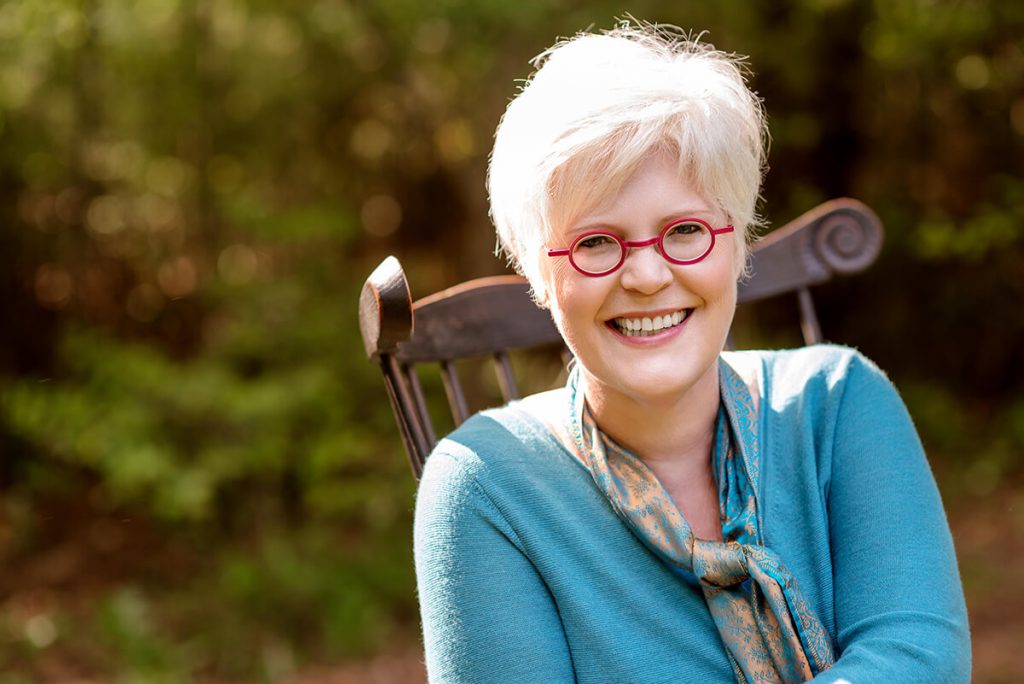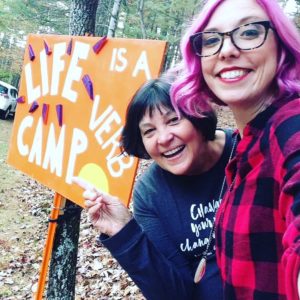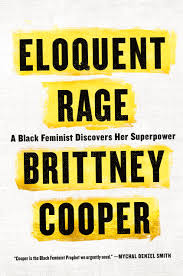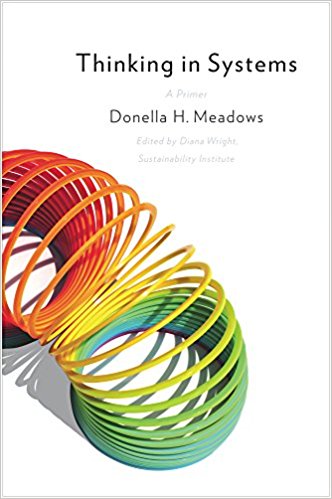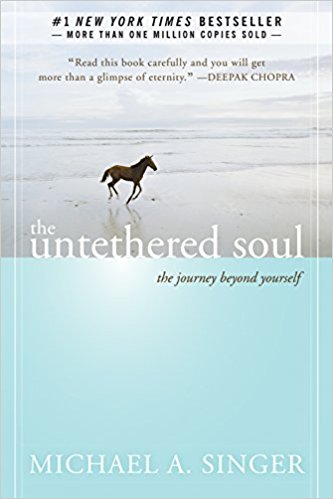A life reboot, writ large.
Rebooting my life. from Patti Digh on Vimeo.I had a heart attack in January 2016. A significant one. The artery they call the “widow-maker” was 90% blocked. I’m very lucky to be here, especially given my doctor’s response to my complaints of chest pain the day before I landed in the ER. My former doctor, I should say.
I left the hospital after a very long week there, and started cardiac rehab weeks later, because I had a complication during the surgery and couldn’t exercise for six weeks. When I started rehab, I took it seriously and never missed one of my 36 sessions. Competitive? No, surely not me.
Friends fed me (us) for quite some time after the heart attack — healthy meals and luscious juices that I devoured. And then, of course, the impact of the moment leaves us, and old habits come back. Not as fully as before, but even though I was a vegetarian for 40 years by the time I had my heart attack, I wasn’t a healthy one.
Now I am. Vegan, even.
I read Dr. Caldwell Esselstyn’s book, Prevent and Reverse Heart Disease, shortly after my heart attack. His findings are significant and it made an impact, and I changed my diet, but not 100% as he recommends. Until December 2016, 11 months after my heart attack.
On December 13, I saw a new doctor, one who is a big proponent of the Esselstyn nutritional plan, particularly for heart patients. My “homework” from that visit was to read the book again and watch “Forks Over Knives” again. I knew he was going to support me in this journey, and he has. That same day, I joined a yoga studio and for one month I went to every yoga class they offered. I’m still going, but only 4-5 days a week, while creating a home practice as well.
On December 19, 2016, I started my new way of eating: a whole foods, plant-based, no-oil diet. No, not even olive oil. And I stopped my Coca-Cola habit the very same day.I’ve lost 40 pounds in the process, so far, and have committed myself to this way of life. There are a few things keeping me on the right track. Here are two of them:
- I have two children who need me, including one who is still living at home and has a disability.
- I have no desire to repeat that heart attack performance ever again in my life. Might I, even after eating this way? Perhaps, but I will have done everything I could to minimize that possibility. This is in my control. My arteries and my genetics may not be in my control, with a father who died at 53 after several heart attacks, but this is 100% in my control. I will not fail myself or those children for a slice of cheesecake or gorgonzola.
Keeping in mind that everyone’s body is different and needs different things, a lot of people have asked how I have done this, so I will outline it below. If you have medical issues, and particularly if you are a heart patient, check with your doctor before embarking on a vastly different lifestyle, eating regimen, and exercise program. This has worked for me – it may not be transferable to your life.
What do I eat?
“I don’t understand why asking people to eat a well balanced vegetarian diet is considered drastic, while it it medically conservative to cut people open.” -Dr. Dean Ornish
I decided I needed to de-emotionalize food. Having been an emotional eater for quite some time, I realized that I needed to substitute movement for emotional eating, and whole foods for sugar. So I eat very simply now. Some might call it boring. I call it simply fuel.
I also plan my week, blocking out time for exercise first, and planning around that. I also plan what I am going to eat the next day, so I have what I need on hand, and I always carry a healthy snack with me (an apple, clementine, banana, or carrots, red pepper strips, etc), as well as a water bottle.
For breakfast, I almost always have steel cut oatmeal cooked for 3 minutes in my Instant Pot, with 1/2-1 tablespoon of chia seeds cooked with it. Chia seeds are loaded with fiber, protein, Omega-3 fatty acids and various micronutrients. I top the oatmeal with a cup of blackberries, raspberries, blueberries, or strawberries. And I drink a cup of tea with soy creamer in it. If I don’t eat cooked oatmeal for breakfast, I eat a cold cereal comprised of rolled oats, shredded mini wheats (not frosted), and Grape Nuts, with non-dairy milk and berries on top.
For a morning snack, I often eat two clementines, or some grapes, or an apple, or a California suncake or Heart Thrive.
For lunch, I most often have a salad of baby kale and/or arugula (4 cups), topped with dressing that has no oil. Or arugula topped with raspberries and a bit of balsamic vinegar. Some days, I will have brown rice with beans for lunch, or a bowl of soup and salad. (This is my favorite no-oil dressing: 2 Tablespoons balsamic vinegar, 1 Tablespoon nutritional yeast,1 teaspoon dijon mustard, 2 teaspoons Tamari, juice from one orange (or lemon or lime, but I like orange the best).
For an afternoon snack, I have raw veggies and/or crackers made without oil and hummus made without tahini.
For dinner, I always have 2 cups of leafy green vegetables (usually steamed kale, but sometimes an arugula or mixed greens salad), and either a baked sweet potato with brown sugar topping, steamed new potatoes with Penzey’s “Fox Pointe” seasoning or salsa, or brown rice and black beans (or another kind of beans) with salsa on top. We also love this Instant Pot vegan chili (note: sauté in water, not oil, and don’t add cheese on top as pictured). Other favorites include cauliflower dal with panch phoron (again, eliminate the oil) over brown rice. I also love lentil soup (again, eliminate the oil and sauté in water or vegan broth).
For an evening snack, I typically have a cup of herbal tea and if I am still hungry, I’ll have a clementine or bowl of berries.
I don’t spend any time trying to “replace” foods I used to eat, because almost always that entails processed foods with oil, even if vegan. Look for lists to get you started, such as this one. Blogs to watch include Fat-Free Vegan, The Happy Herbivore, and Minimalist Baker. Some of their recipes have oil in them, but it is so easy to sauté vegetables in veggie broth, water, wine, or almost any other liquid. Cookbooks I enjoy include Vegan Under Pressure, any cookbook by Kathy Hester, The Oh She Glows Cookbook, and any of Isa Chandra Moskowitz‘s cookbooks. Please note: you will need to eliminate the oil from some of these recipes. When sautéing, this is easily done with water or broth (or beer or wine), and when baking, I replace oil with unsweetened applesauce. Because applesauce is very moist, the recipe may need to be slightly altered to achieve the desired texture. Slightly decrease the amount of other liquids in your recipe or use less applesauce than the amount of oil required. If your recipe calls for 1 cup of oil, try replacing it with 3/4 cup of applesauce. To replace eggs in your favorite cake recipes, there are several options.
This way of life will require you to read ingredient lists of all foods, as many foods have oil in them, even if they meet the vegan requirement. Eating out requires diligence in asking for foods not cooked in oil as well as vegan options (which are readily available in many places).
According to Dr. Esselstyn, the following foods cannot be eaten if a heart healthy diet is to be effective.
- Anything with a face or a mother. This includes meat, poultry, fish and eggs.
- Dairy products that include butter, cheese, cream, ice cream, yogurt, milk and skimmed milk.
- Oils: All oils including olive oil and canola oil.
- Refined grains: White rice, “enriched” flour products that are found in pastas, breads, bagels and baked goods.
- Nuts: Individuals with heart disease should avoid all nuts. Those without the disease can consume some walnuts which provide considerable omega-3 fatty acids.
Please note that Dr. Esselstyn is clear about the fact that these foods are not to be eaten, not even in moderation. I can attest to the fact that it seems impossible to eat without oil, but isn’t. And on a recent business trip when I tried to eat a lentil salad that I have always enjoyed in Chicago, I couldn’t eat it because there was too much oil on it. In just a few weeks, my tastes had completely changed.
Foods That Are Allowed on the Esselstyn plan:
The following are foods needed to promote heart health by a cholesterol lowering diet.
- Vegetables – Just about all vegetables are permitted on this plan with the exception of avocados. If you are a cardiac patient avocados have a very high fat content. Those that do not have heart disease may eat avocados as long as blood lipids are not elevated.
- Legumes – Beans, peas, and lentils of all kinds.
- Whole Grains – Just about any grain as long as it is “whole” grain. “Whole” means that it has not been polished or processed to eliminate much of the nutritional value. You should eat breakfast cereals that do not contain added oil and sugar. Breads should be whole grain without added oil. Whole grain pastas are allowed. You should be careful of restaurant pastas that almost always contain eggs, white flour and some oil.
- Fruit – Fruit of all kinds are permitted. It’s best to limit fruit consumption to three servings a day. Also, avoid consuming pure fruit juices since you get excessive amounts of sugar that will elevate your triglycerides. Be careful of all desserts for the same reason.
- Beverages – The heart healthy diet allows the following beverages. Water, seltzer water, oat milk, no-fat soy milk, coffee, and tea. Alcohol is okay in moderation.
Supplements
For those who have heart disease, a heart healthy diet includes supplements and Dr. Esselstyn recommends the following:
- Multivitamin – One a day that covers all the basic requirements.
- Vitamin B12 – 1000 mcg (micrograms) daily.
- Calcium – People over 50 should take 1000 milligrams daily…over 60 take 1200 mg daily.
- Vitamin D – Those over 50 should take 1000 IU daily.
- Omega Fatty Acids – Consume one tablespoon of flaxseed meal each day. Perhaps sprinkling on your cereal. Keep flaxseed meal refrigerated.
- Cholesterol – lowering drugs (if necessary).
I only take a daily Vitamin B12 and a daily liquid supplement of Vitamin D from this list, and get my omega fatty acids from chia seeds and flaxseed meal. Since I started on the Esselstyn plan, my blood pressure has regulated to the point of eliminating the blood pressure medication I have taken for years. In addition to losing 40 pounds in 3 months, my cholesterol has been reduced so much that my cardiologist took me off the statin I had taken since my heart attack. My total cholesterol is now 101, HDL is 37, and LDL is 38. The body responds.
What exercise do I get?
I walk a minimum of two miles a day with our dogs, and often more. Once a week, we go hiking with the dogs in Dupont State Forest. And I do yoga every day, even if it is a short practice at home. It centers me into my body in a way I haven’t been in some time. Evidently when you have PTSD, as I do, one hallmark is the dissociation with your body, and yoga is fantastic for reconnecting brain to body. Being reconnected also means that I don’t eat mindlessly anymore. Everything becomes more intentional. Can’t go to yoga classes? Check out Yoga with Adriene on YouTube. Soon, I’ll be adding swimming to my workout rotation, and weight training.
How do I keep track?
I started using an app on my phone called Lose It! and it has been a fantastic support to me. While my deepest goal wasn’t to lose weight, but to have healthier endothelium in my arteries, losing weight also eliminates the final “risk factor” I have for heart disease. I track the exercise I do daily, as well as what I eat, and the percentages of fat, protein, and fiber painlessly with this app, and it allows me to plan the next day’s food and exercise so I can make sure I have on hand what I need.
For those who have asked, or those who have cardiac disease as I do and want to start their own reboot, I hope this provides a start.


